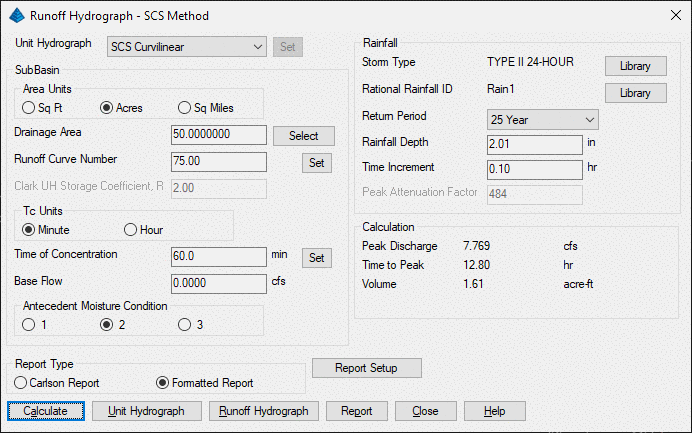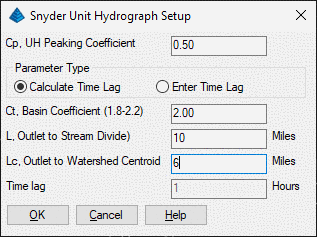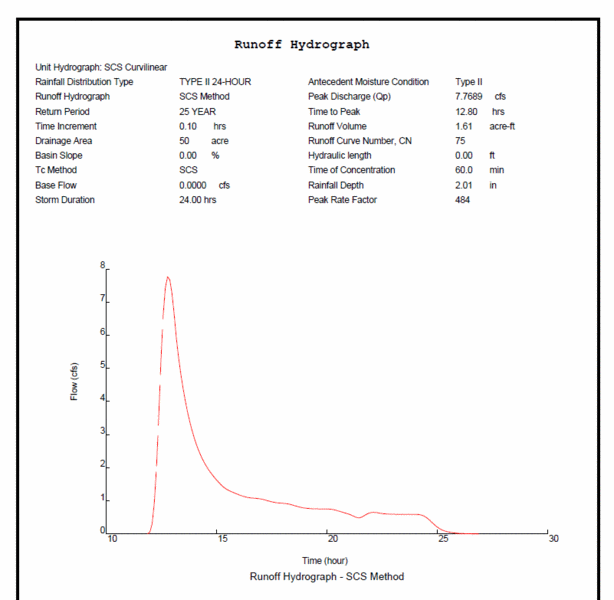This function applies the SCS hydrograph procedure and the same
methodology as used in TR-20 to generate runoff hydrograph by
specifying either a triangular hydrograph shape or a curvilinear
one. There are five unit hydrograph options: Delmarva, SCS
Curvilinear, SCS Triangular, Clark and Snyder unit hydrograph
method. The SCS method is best suited for large watersheds.

SCS Curvilinear Unit Hydrograph uses the dimensionless unit hydrograph developed by Victor Mockus. This dimensionless hydrograph has its ordinate values expressed in a dimensionless ratio Q/Qp (discharge at time t to total discharge) or Qa/Q (accumulated volume at time t to total volume) and its abscissa values as T/Tp (time t to peak time). When calculating the unit hydrograph for certain watershed, Delta, the internal calculation increment, is 0.1333Tc for each given subarea. Slightly adjust Delta so that Tp on the unit hydrograph will fall exactly on one of the ordinates spaced at Delta. This method creates the unit hydrograph for one inch of direct runoff using the 51 evenly spaced Q/Qp ratios used internally by TR-20.
SCS Triangular Unit Hydrograph uses an equivalent
triangular hydrograph having the same units of time and discharge
to represent the dimensionless curvilinear unit hydrograph. Please
refer to National Engineering Handbook Section 4 for the equations
used in generating both SCS Curvilinear and SCS Triangular unit
hydrograph.
Delmarva Unit Hydrograph is an alternative to the 484 dimensionless unit hydrograph developed for the Delmarva region (Delaware, Maryland, Virginia peninsula) based on data from four gaged watersheds. Peak rate factor of 284 is used in this method.
Clark Unit Hydrograph is a synthetic unit hydrograph
method. There's no need to develop a unit hydrograph through the
analysis of past observed hydrograph. Instead, a time vs. area
curve built into the program is used to develop the translation
hydrograph resulting from a burst of precipitation. The resulting
traslation hydrograph is routed through a liner reservoir to
account for storage attenuation effects across the subbasin. The
time of concentration defines the maximum travel time in the
subbasin; the storage coefficient is used in the linear reservoir
that accounts for the storage effects.
Snyder Unit Hydrograph is based on a study of watersheds
in the Appalachian Highlands. In basins ranging from 10 to 10,000
square miles.
Snyder relations are: tp =
Ct(LLc)0.3
Where:
tp = basin lag (hr)
L = length of the main stream
from the outlet to the divide (mi)
Lc = length along the
main stream to a point nearest the watershed centroid (mi)
Ct = Coefficient usually
ranging from 1.8 to 2.2
Qp = 640CpA/tp
Where:
Qp = peak discharge of
the unit hyrograph (cfs)
A = drainage area
(mi2)
Cp = storage coefficient
ranging from 0.4 to 0.8, where larger values of Cp are
associated with smaller values of Ct

Select SCS Method from Watershed > Hydrograph Routing >
Watershed Hydrograph menu. This command opens a dialog for
hydrograph calculation. First choose which method to use, SCS
Curvilinear or SCS Triangular. Then enter the sub-basin and
rainfall data. When creating an SCS Triangular unit hydrograph, you
need to enter the unit hydrograph peak attenuation factor, which
controls the area under the unit hydrograph before the time to
peak. Usually a factor of 484 is used. This factor varies from
about 600 in steep terrain to 300 in very flat swampy areas. When
creating an SCS Curvilinear unit hydrograph, the peak attenuation
factor is default to 484.
The program can get Rainfall Depth automatically based on user
specified Rational rainfall ID, return period and time of
concentration.
After entering all information, click Calculation button to
generate the unit and runoff hydrograph. Unit Hydrograph button and
Runoff Hydrograph button open a dialog with the tabular and graphic
data of the unit and runoff hydrograph correspondingly, from there
you can draw the hydrograph on screen, generate the hydrograph data
in the report format and save the hydrograph to a file.
The calculation result can be reported in PDF format with design
data and hydrograph curve.
|
|
| Unit Hydrograph Dialog |
|
|
| Runoff Hydrograph Dialog |
